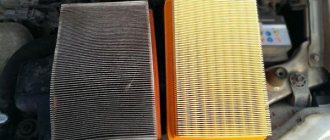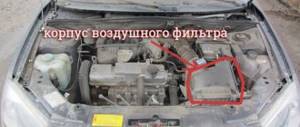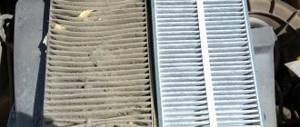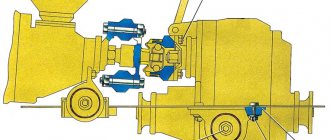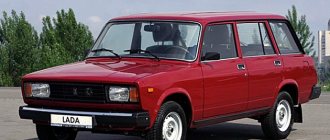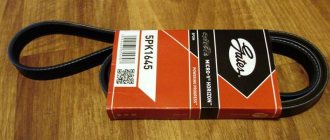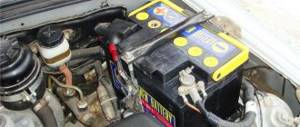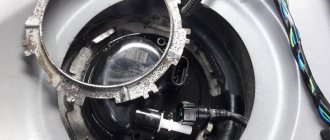The standard approach to testing automotive filters usually takes one sample and examines it separately from the entire fuel system of the vehicle. Such an examination according to GOST does not contain useful information, since the filter is not an autonomous element, but a part of the entire engine lubrication system. Based on this, we decided to apply an original method for evaluating oil filters - checking not so much the cleaning component itself, but its “compatibility” with the car’s fuel system. Thanks to the analysis, you will be able to find out the real service life of oil filters, different from the declared one.
But first, let's figure out what algorithm the oil filter actually uses and whether there are any nuances in its operation.
The nuances of the oil filter and the frequency of its replacement
Of course there is. We won’t focus on the structure of the oil filter and its main functions; we’d rather talk about a small nuance of its operation. Perhaps you will discover that as the paper storage device becomes dirty, the quality of filtration...increases. This happens due to clogging of the pores and, as a result, a decrease in throughput. Deposits of dirt remain “on this side”, making it difficult for sludge to pass into the engine cylinders. However, it will be more difficult for clean oil to pass along with wear products, and over time this is generally impossible. Therefore, from the point of view of a “filter fan,” instead of special paper, it is better to use thin metal foil, which does not allow dirt to pass through. And, at the same time, oils!
From the opposite point of view of the “engine fan”, it is better if there is no filter at all. However, its absence should not affect the purity of the oil. It is on this principle of struggle and unity of opposites that the entire work of the fuel system is based. Dirt accumulates, the quality of filtration increases, but so does the resistance. This leads to the fact that the pressure behind the filter drops so much that the friction units are practically without lubrication. And here the bypass valve comes to the rescue: it opens and allows uncleaned oil to bypass the filter. From this moment, oil filtration stops and active wear of the main engine components begins.
Based on this, every motorist should come to a conclusion about when to change the oil filter. What do manufacturers say about this? They promise 10-15 thousand km of trouble-free mileage. But is this true in reality? The service life of the oil filter depends not only on the mileage, but also on the quality of the engine oil, operating conditions (weather, mode) and the condition of the engine. Therefore, one should not meticulously adhere to the strict framework of technical regulations. It is better to study the characteristics of the fuel system of your car, so you will have an idea of the real resource of “your” oil filter.
Air filter functions
To start an engine, you need fuel and air. They form a flammable mixture, which, when ignited, starts the engine. This filter is installed at the inlet of the system, immediately after the air intake.
Its purpose is to filter out all harmful impurities, litter, dust from the incoming air, which our atmosphere is rich in. If this element were not there, then contaminants would penetrate into the engine, clog its components and mechanisms, and contribute to the unstable operation of the power unit and its premature failure.
Let us recall that for normal operation of a gasoline or diesel internal combustion engine, it is necessary to obtain 15 kg of purified air from the atmosphere per 1 kg of fuel. The filter must fully supply the engine with this important component of the fuel mixture.
The filter consists of a housing and a filter element.
- Frame.
- Filter element.
When the car is used intensively, the filter quickly becomes clogged. If you do not replace it for a long time, it loses its capacity and less air enters the machine.
This risks creating an enriched mixture that does not burn completely and pollutes the atmosphere with harmful substances at the exit.
At the same time, fuel costs increase, the power plant loses power, and parts wear out faster.
In order not to waste money on premature engine repairs, drivers should regularly change the air filter according to maintenance. If a car enthusiast often travels along dusty country roads in the summer, replacement must be done more often.
Why are filters different?
Indeed, why do filters vary so much in their functionality? After all, they are all certified, recommended and work properly for the benefit of the car’s fuel system. We, of course, are not filter experts, but during testing of cleaning elements we formed our opinion on this issue.
There are three components that divide filters into good and bad - the amount of filter paper, the accuracy of its placement technology, structure and density. The bypass valve also has an effect on something. Unfortunately, the testing procedure according to GOST does not take these differences into account, because assessing the quality of filtration of reference dust does not reflect the actual multifactor structure of engine oil contamination. But the difference is fundamental - solid substances are deposited on the surface, and the products of decomposition of the lubricating fluid are filtered out by the volume of paper filler. Therefore, thicker paper, with a high density, will always be better at filtering organic particles. And this factor is not controlled in any way! Everything is clear regarding the amount of paper, let’s look at the quality of its placement. Imagine a cartridge where part of the corrugated paper is “molded”. If the folds of paper are stuck together on one side of the cartridge, then on the other they will be sparse. Because of this, dirt will begin to clog the “glued” part of the folds and it will become like a blank wall that allows absolutely nothing to pass through. Filtration will be carried out only due to the sparse part, but its area is not at all the same! Hence the difference.
Our testing methodology
To analyze oil filters, we applied a unique testing technique, which consists of assessing the resistance of filters at different stages of contamination in various operating modes. How was this done?
We purchased two dozen pairs of brand new filters from various brands from large auto stores in the capital. A separate copy of each brand was opened and the opening pressure of the bypass valve was measured. The second samples were sent for motor bench tests. So, first we installed an empty filter on the motor, without a cartridge, and measured the reference pressure characteristic of the pump. The purpose of this experiment is to establish an initial “mark” from which the reduction in pressure in the filters should be measured. The procedure was carried out using pure oil. Next, we started testing the filters. We took oil pressure readings in the same modes as with a filter without a cartridge. At the third stage, the oil filter should have been clogged. To do this, we added a mixture of special dust, aluminum powder and “heavy” fuel oil-like organics to the pure oil. We calculated the amount of reference dirt in advance by analyzing the spectral characteristics of used oil, as well as using readings of dust passing through air filters. We introduced the test mud gradually in equal portions so that it had time to settle evenly on the filter paper. After each injection of dirt, the decrease in pressure in the fuel system was assessed. To meet the required deadlines, after each portion of the pollutant was produced, the data obtained was processed by drawing a pressure drop line until the bypass valve opened. Thus, we tested each brand of filter separately, interrupting only to flush the engine using a special technology.
During the tests, we checked not only the quality of filtration of the polluting mixture, but also monitored such parameters as the price of the product, appearance and design features. Why evaluate these indicators? Moreover, the quality of manufacture of the oil filter guarantees the stability of its operation as a whole.
Varieties
Let's focus on the types of components. Each is characterized by specific parameters that determine efficiency, cleaning method, and technical parameters.
| Types of engine filtration devices | |||
| Inertial | Inertia-oil | Paper | Zero resistance devices |
| Such devices are already outdated, although a certain effect can be achieved with them. The device has a voluminous body with a fishing line cushion inside. The air is purified in the primary cycle because the direction of movement changes, and the air continues to move by inertia. As a result, contaminant particles settled at the bottom of the container. | Experts consider them more effective when compared with conventional inertial models. But they are already classified as obsolete models. The design is similar to inertial ones, but additional oil is used: it increases the ability to capture and retain clogging particles of various sizes. | Received the greatest distribution. The air is purified thanks to a special paper material with a porous texture. The paper is multi-layered, which ensures thorough cleaning when air passes through it. The fibers are interwoven so tightly that they are able to trap tiny particles less than one micron in size. | Cleaning is ensured by foam rubber or cotton material. Parts are treated with special compounds to increase efficiency. Experts note: such models are more durable, they can be cleaned and then continued to be used. |
Most often, car enthusiasts opt for paper models, but devices with zero resistance also deserve special attention.
Zero resistance filter
Nowadays, the zero-resistance model for cars is becoming increasingly popular. Its feature is the ability to pass air freely, without supply delays. The maximum feed speed increases, acceleration becomes less.
The basic value of the material from which the devices are made: it has large pores, and a minimal amount of paper is used. Traditionally, the basic element is a special cotton fabric, as well as a special aluminum screen.
There are two main types of filtering devices with zero resistance.
| Without impregnation (dry) | Using impregnation |
| More similar to a conventional filtration device, but made from different materials. Here the increase in power level will be approximately 5%. | The most efficient device. Made from multi-layer fabric material impregnated with a modern oily texture composition. All kinds of clogging elements are retained in the impregnating layer. Power increases on average by 7%. |
The impregnated type is widely used due to its positive characteristics. But we must remember its shortcomings. The need for frequent rinsing is key. This will have to be done after three thousand kilometers. Otherwise, the quality of filtration will decrease sharply.
Oil filter categories
The banal formulation of many companies did not suit our commission in any way. It might be the right size, but for which cars is it recommended? For new ones driving along the highways, or for loaded, workhorses pulling trailers over rural off-road conditions? In connection with this condition, we decided to divide the cars for which oil filters are recommended into 3 categories - “Premium class”, “Middle class” and “Economy class”.
The first category involves a brand new car driving on the autobahn using expensive synthetic oil. The rate of aging of motor oil for this type is low; heavy organic substances accumulate slowly. Therefore, the service life of the oil filter is assessed here first.
“Economy class” includes cars that are the opposite of the first category. High wear, increased crankcase gas pressure and oil consumption. The lubricating fluid itself is cheap, mineral, and ages quickly - crankcase gases help. On these types of engines, the first priority is the filter’s retention of heavy decomposition products, and the resource, in principle, is not critical: in any case, an oil change is required after 5-7 thousand km. Yes, price plays a big role - people of modest means drive such cars.
The “middle class” includes cars in which everything is equal – both the quality of filtration and the service life of the oil filter.
Since each category has its own priorities, we used different weighting coefficients. In the table you can see, highlighted in red are those that are most suitable, and in blue those that we would not recommend using for any category of engines. The placement of filters is marked by the sum of points that each test specimen scored for such parameters as: filtration quality, cost, resource and appearance.
In general, we noticed that the “Europeanized” operating conditions for “Premium Class” filters are better guaranteed by European brands. And our domestic brands of filters ensure a long life for our “Economy” in the conditions of difficult Russian life. Bosch performed well – it performed “excellent” in all categories. SCT also distinguished itself – albeit for the worse. “Livny” successfully demonstrated its work, however, nothing surprising - the paper filler was not made by us, and it was layered 1.5-2 times more than others. Now, only the technology and design of the cartridge are clearly lame on both legs.
How was it assessed?
Since each class has its own priorities, we used different weight parameters. For the convenience of the reader, we have highlighted the table values in different colors: red - what is most suitable and blue - what should be used with caution for all categories of engines. The oil filters were ranked according to the sum of points scored by the applicants for overall impression, service life, filtration quality and price. The final ratings in the ranking are arranged from best to worst: the first filter with the highest score received an o, the last one received a rating of “1”, the rest filled the middle. This tabular correlation of data will allow the reader to move away from an integral assessment to an individual one - to choose a product with a higher resource, filtration quality, etc.
Oil filter rating
18th place: SCT SM 101
It is designed well, but the parameters are far from ideal. Perhaps the European approach to the properties of paper filler and its obvious disadvantage are to blame. The “soft” valve also made its contribution, with an effort pressure half that of everyone else. As a result, the resource is completely absent.
Advantages: Low cost, good performance.
Disadvantages: The smallest resource, in the end the last line in all three categories.
17th place: Olefant OF-54
Approximate price – 90 rubles.
He did not show himself in any particular way at work. It tries to filter, but the quality of retention of harmful substances lags behind other cleaning elements.
Advantages: Low cost
Disadvantages: Solid penultimate place for all classes: the resource is small, filtering is not the best.
16th place: NAC Genuine parts 2—8833
Approximate price – 90 rubles.
When producing this product, the manufacturer greatly regretted the filter paper, which significantly reduced the quality of filtration. The cleaning element will, of course, work, but not for long.
Advantages: Low cost of imported products.
Disadvantages: In almost all respects it is inferior to its counterparts - there is nothing to praise for.
15th place: Fenom FN994
Approximate price – 90 rubles.
The manufacturer has slightly improved the characteristics of this filter, and therefore the performance of all parameters has increased. However, the Korean touches of NAC, with which Fenom is closely related, still did not allow the product to take its rightful place.
Advantages: In general, not the worst resource and real cost.
Disadvantages: Smallest filtration area due to lack of paper.
14th place: GoodWill OG 410
Approximate price – 75 rubles.
The very diligent execution is striking, but in terms of resource it is much inferior to other European “colleagues”. On the contrary, somehow closer to their Russian “brothers”. On average, it’s very good, reliable, stable and inexpensive.
Pros: Inexpensive, mid-level filter.
Disadvantages: The resource is inferior to other European-made filters. It is better not to use with “long-lasting” motor oil.
13th place: Finwhale LF105
Approximate price – 100 rubles.
A typical universal filter made in Europe, with a good service life.
Advantages: Large resource, low cost.
Disadvantages: It is better not to install it on old cars, as it does not cope well with fuel oil-like formations.
12th place: Mechanic M fsm 237
Approximate price – 55 rubles.
Updated Citron product. Works much better than before. They did not spare the papers and improved other indicators.
Advantages: Leader in filtration. Well suited for middle class cars. Very attractive price.
Disadvantages: Carelessly made: uneven corrugation, folded folds in places.
11th place: Tutela 30 3/4" x 16UNF
Approximate price – 340 rubles.
The design is similar to the Champion filter, but the paper is smaller. As a result, the parameters are worse.
Advantages: Optimal indicators in terms of resource and filtration quality.
Disadvantages: The bypass valve pressure is twice as high as other filters and can lead to oil starvation. The price is unreal!
10th place: Hengst H12W05
Approximate price – 105 rubles.
The filter is of European origin, but the parameters clearly gravitate towards Russian conditions. Overall, stable in all respects.
Advantages: Beautiful and high-quality universal filter with above-average performance.
Disadvantages: Expensive.
9th place: Fram PH5822
Approximate price – 70 rubles.
The filter boasts above-average performance and is not overpriced.
Advantages: Suitable for engines in any condition. Inexpensive and above average.
Disadvantages: You can’t help but expect more laudable achievements from a popular brand.
8th place: Champion C230
Approximate price – 100 rubles.
The appearance is quite good, but the filtration area has become smaller. Overall, good performance in all respects.
Advantages: Equal results for all categories: from premium class to economy.
Disadvantages: The tightly packed paper filter does not like dusty roads.
7th place: Superfilter Kolan
Approximate price – 130 rubles.
The filter has very decent performance in all respects. True, it does not live up to expectations for working with oil decomposition products.
Advantages: Good filtration quality, service life above average, effective for all types of engines.
Disadvantages: No packaging, defects in body painting, uneven corrugation, high price.
6th place: PEKAR 2108—1012005
Approximate price – 70 rubles.
Typical representative. Good results are ensured by high paper density and a wide filtration area. It is worth working only with the resource.
Advantages: Inexpensive cost of the filter, well suited to the average Russian consumer.
Disadvantages: Small resource.
5th place: Delpfi FX0019
Approximate price – 85 rubles.
The filter has the most original design: this is evidenced by the size of the housing, the design of the cartridge, and the structure of the bypass valve.
Advantages: Leader in the premium class environment. Optimal resource and normal cost.
Disadvantages: Does not share the excitement of driving on dusty off-road roads, since the paper is European and its packing density is small.
4th place: Nevsky filter NF-05-M
Approximate price – 65 rubles.
The filter uses a lot of thick, high-density paper, which, of course, significantly reduces the pressure, but also increases filtration. The price is very reasonable. The overall impression is positive – and the price is captivating.
Advantages: Universal filter for all parameters.
Disadvantages: Relatively small resource.
3rd place: Livny 2105—1012005
Approximate price – 70 rubles.
Champion in filtration area. They managed to cram in twice as much paper as other filters. Overall, it’s not bad, but it lacks aesthetics, since after opening it, a rather poor design and manufacturing technique was discovered.
Advantages: Leader in filter area. The resource is higher than that of the “Europeans”.
Disadvantages: Very poor level of workmanship.
2nd place: Mahle OC384
Approximate price – 90 rubles.
Quite a nice product of European origin. Noble exterior, reliability and low price! Excellent uniformity of filter paper placement, as well as an even cartridge ensure stable operation. In terms of resources, it can be called the best.
Advantages: High quality workmanship. Suitable for premium and middle classes, it demonstrates typically European character traits on the road.
Disadvantages: The filtration quality of one of the leaders could be better.
How to choose a cabin filter
Choosing a cabin filter for a car is a very complex process that has no guidelines for standard indicators. Due to the specifics of the products, it is very difficult to highlight key characteristics, but Expertology editors managed to collect 9 very important recommendations for you.
- When selecting a cabin filter, be sure to rely on the catalog number of the original product.
However, it is advisable to purchase not originals, but analogues from well-known manufacturers. This choice will not only save a lot of money (about 50-75%), but will also provide equally high-quality air purification for a long time. - Make sure that the filter you purchased is installed correctly in the seat
. Pay attention to the tightness of its fastening and the absence of strong curvature of the fabric plates. Give preference to models that have elements for strengthening the body in the form of glued corners or plastic (rubber) frames. - The filter material must have special treatment
. The part located on the fan side is usually subjected to surface lamination. This is necessary in order to avoid lint getting into the ventilation, otherwise it can both cause contamination of the flowing air (and, moreover, a powerful allergen) and reduce the performance of the entire air conditioning system. - A large box
is not always a sign of a fake. Many manufacturers deliberately increase the size of packaging boxes in order to reduce the likelihood of damage to cabin filters during transportation and storage. However, many users mistakenly perceive this precaution as a fact of falsification. - Marking
the direction of air flow is a very convenient thing. It avoids the hassle of installing the filter incorrectly. Therefore, we advise you to give preference to those products that are marked “Top” and “Bottom”. - The presence of activated carbon
is more than a simple advertising ploy. Everyone knows firsthand about the benefits of activated carbon in absorbing certain gases, including nitrogen dioxide and hydrocarbon compounds. So if maintaining health is not just empty words for you, and you are willing to spend a little more money, then we strongly recommend purchasing carbon filters. - The weight of the carbon filter
is a very important characteristic. In general, the higher its mass, the more activated carbon the fabric plates contain. - When purchasing a carbon filter, be sure to check the integrity of the packaging
. The fact is that the presence of through holes in a paper box or polyethylene can provoke the “exhalation” of a certain portion of activated carbon due to the creation of an air flow. Hence the obviously lower working life and possible mechanical damage. - strongly do not recommend measuring filter life in kilometers
- this approach does not work with these products. The characteristics of their durability are influenced by a lot of indicators, such as gas and dust levels of the locations in which you have to move, as well as the operating modes of the air conditioner. According to this logic, the most optimal measure of resource is the period of operation, and, from personal experience, let’s say: the average resource of any filter (simple or carbon) will vary from 9 to 12 months.

